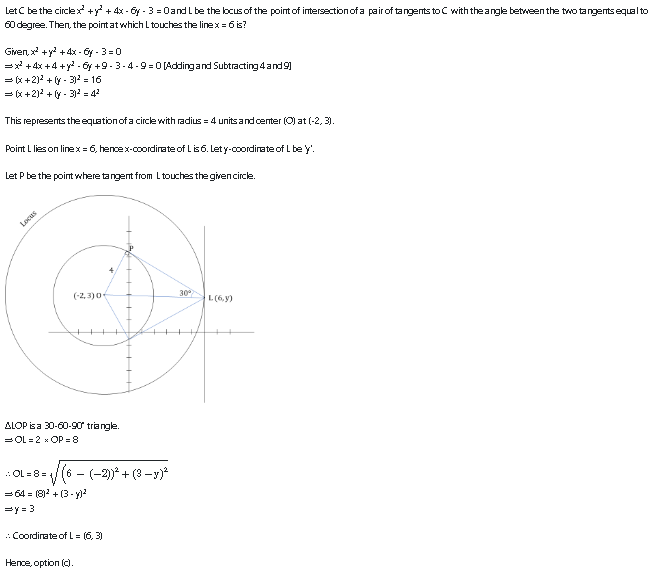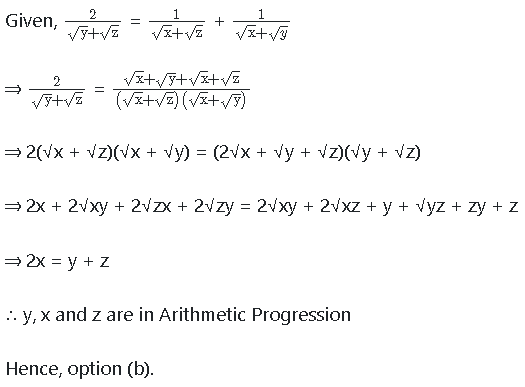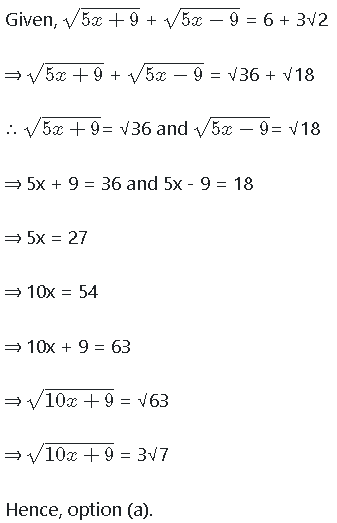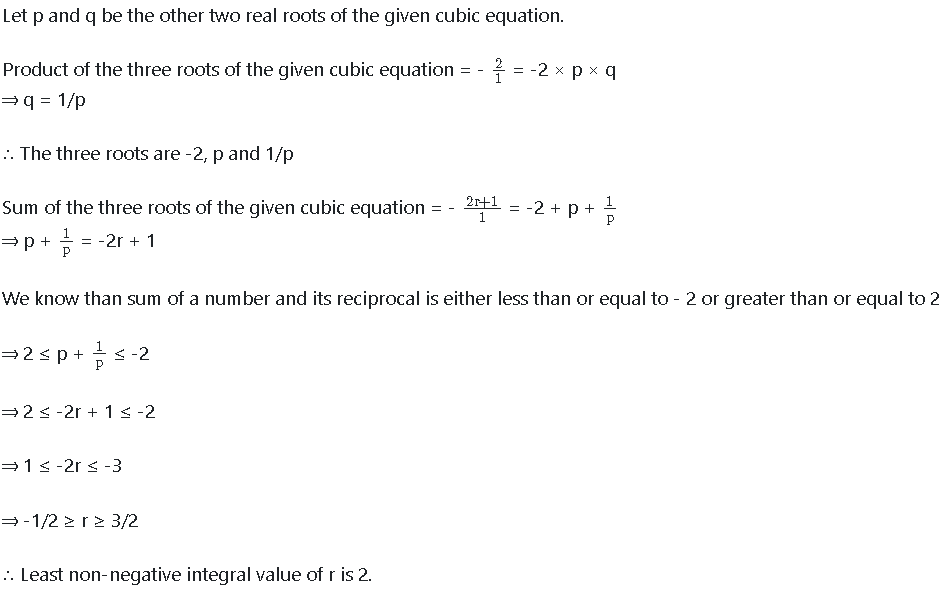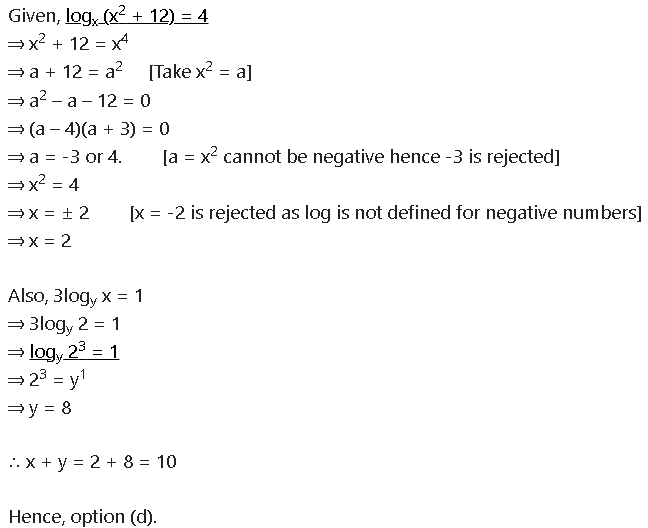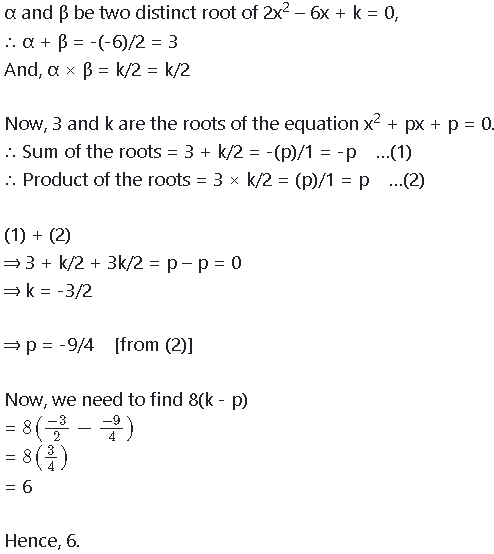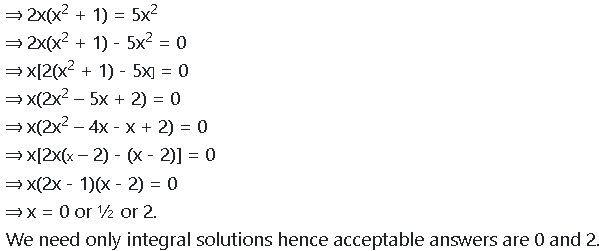Live Updates
• CATKing has launched new chat bot.

• New video on Logs has been released.
495
Learners
asked the doubt

Previous Year Questions
What is the maximum possible value of the total time (in minutes, nearest to its integer value) required to process all applications in the Others category on that day?
Video Explanation

Explanatory Answer
There are 20 slots of 15 minutes each from 9:00 AM to 2:00 PM. There are ten counters in the VPO.
From the given information and condition (1), Total number of applications scheduled = 10 × 20 = 200
From condition (3), Number of US applications = 100. Number of application for rest 3 categories = 100.
From condition (2), Number of US applications for each slot = 100/20 = 5. Similarly, number of applications of rest 3 categories for each slot = 100/20 = 5.
The processing time for an application is the same within each category. But it may vary across the categories.
Depending on the number of applications in a category and time required to process an application for that category,
it is possible that an applicant for a slot may be processed later.
The information can be shown in the table below.

Step 2:
On a particular day, Ira, Vijay and Nandini were scheduled for Schengen visa processing in that order. They had a 9:15
AM slot but entered the VPO at 9:20 AM i.e., they had delayed by 5 minutes.
So at least 3 people were scheduled for each slot for a Schengen visa.
Mahira and Osman were scheduled in the 9:30 AM slot on that day for visa processing in the Others category.
So at least 2 people were scheduled for each slot for an Others category visa.
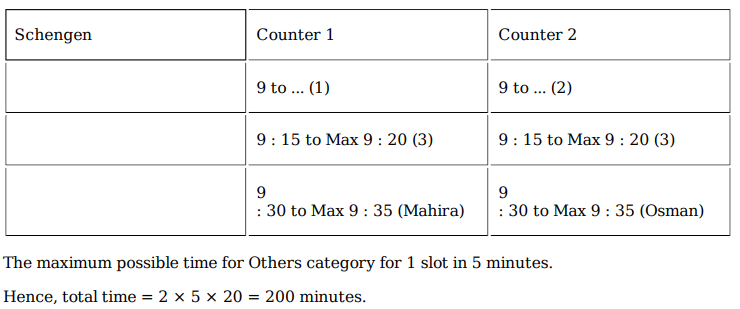
Which of the following is the closest to the time when Nandini's application process got over?
Video Explanation

Explanatory Answer
There are 20 slots of 15 minutes each from 9:00 AM to 2:00 PM. There are ten counters in the VPO.
From the given information and condition (1), Total number of applications scheduled = 10 × 20 = 200
From condition (3), Number of US applications = 100. Number of application for rest 3 categories = 100.
From condition (2), Number of US applications for each slot = 100/20 = 5. Similarly, number of applications of rest 3 categories for each slot = 100/20 = 5.
The processing time for an application is the same within each category. But it may vary across the categories.
Depending on the number of applications in a category and time required to process an application for that category,
it is possible that an applicant for a slot may be processed later.
The information can be shown in the table below.

Step 2:
On a particular day, Ira, Vijay and Nandini were scheduled for Schengen visa processing in that order. They had a 9:15
AM slot but entered the VPO at 9:20 AM i.e., they had delayed by 5 minutes.
So at least 3 people were scheduled for each slot for a Schengen visa.
Mahira and Osman were scheduled in the 9:30 AM slot on that day for visa processing in the Others category.
So at least 2 people were scheduled for each slot for an Others category visa.
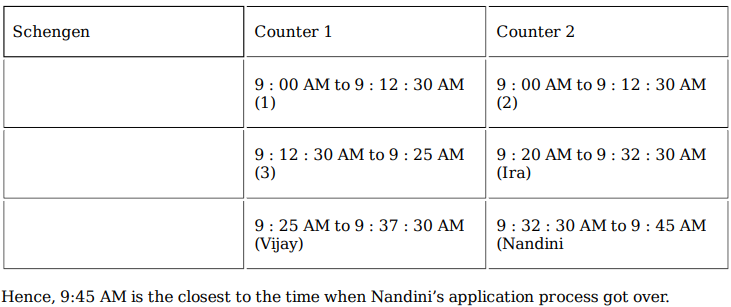
Which of the following statements is false?
Video Explanation

Explanatory Answer
There are 20 slots of 15 minutes each from 9:00 AM to 2:00 PM. There are ten counters in the VPO.
From the given information and condition (1), Total number of applications scheduled = 10 × 20 = 200
From condition (3), Number of US applications = 100. Number of application for rest 3 categories = 100.
From condition (2), Number of US applications for each slot = 100/20 = 5. Similarly, number of applications of rest 3 categories for each slot = 100/20 = 5.
The processing time for an application is the same within each category. But it may vary across the categories.
Depending on the number of applications in a category and time required to process an application for that category,
it is possible that an applicant for a slot may be processed later.
The information can be shown in the table below.

Step 2:
On a particular day, Ira, Vijay and Nandini were scheduled for Schengen visa processing in that order. They had a 9:15
AM slot but entered the VPO at 9:20 AM i.e., they had delayed by 5 minutes.
So at least 3 people were scheduled for each slot for a Schengen visa.
Mahira and Osman were scheduled in the 9:30 AM slot on that day for visa processing in the Others category.
So at least 2 people were scheduled for each slot for an Others category visa.
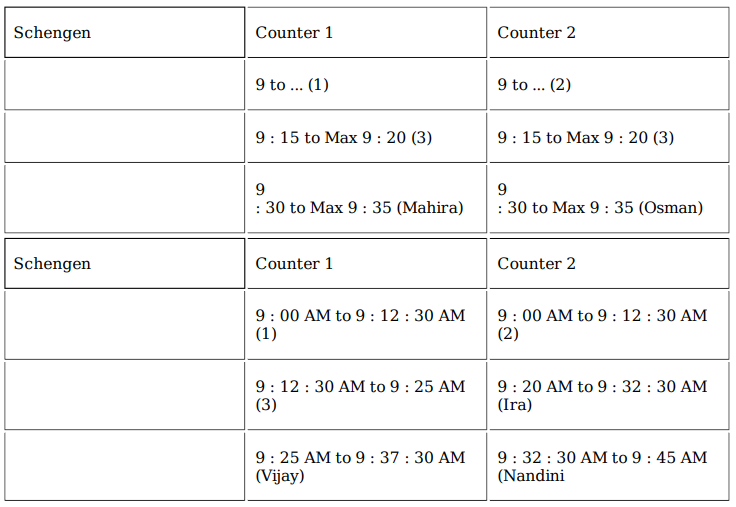
When did the application processing for all US applicants get over on that day?
Video Explanation

Explanatory Answer
There are 20 slots of 15 minutes each from 9:00 AM to 2:00 PM. There are ten counters in the VPO.
From the given information and condition (1), Total number of applications scheduled = 10 × 20 = 200
From condition (3), Number of US applications = 100. Number of application for rest 3 categories = 100.
From condition (2), Number of US applications for each slot = 100/20 = 5. Similarly, number of applications of rest 3 categories for each slot = 100/20 = 5.
The processing time for an application is the same within each category. But it may vary across the categories.
Depending on the number of applications in a category and time required to process an application for that category,
it is possible that an applicant for a slot may be processed later.
The information can be shown in the table below.

On a particular day, Ira, Vijay and Nandini were scheduled for Schengen visa processing in that order. They had a 9:15
AM slot but entered the VPO at 9:20 AM i.e., they had delayed by 5 minutes.
So at least 3 people were scheduled for each slot for a Schengen visa.
Mahira and Osman were scheduled in the 9:30 AM slot on that day for visa processing in the Others category.
So at least 2 people were scheduled for each slot for an Others category visa.
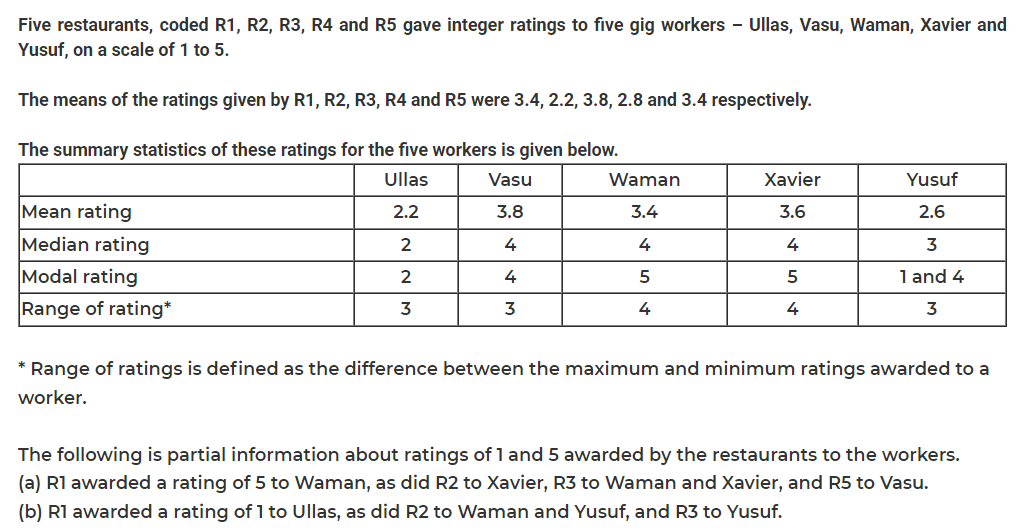
How many individual ratings cannot be determined from the above information?
Video Explanation

Explanatory Answer
Step 1:
Mean rating of Ullas is 2.2. So his total rating = 2.2 × 5 = 11.
Since his median rating is 2.
So his middle most rating is 2.
Since his mode rating is 2. So his one more rating is 2.
Since his range of rating is 3. So his two ratings are 1 and 5 or 2 and 5 or 1 and 4.
Hence, only possible ratings of Ullas is (1, 2, 2, 2, 4).
Mean rating of Vasu is 3.8. So his total rating is 3.8 × 5 = 19. His median rating is 4. So his middle most rating is 4.
His mode rating is 4. So his one more rating is 4.
Since range of rating is 3. So only possible ratings of Vasu is (2, 4, 4, 4, 5).
Similarly, possible ratings of Waman, Xavier and Yusuf are (1, 2, 4, 5, 5), (1, 3, 4, 5, 5) and (1, 1, 3,
4, 4) respectively
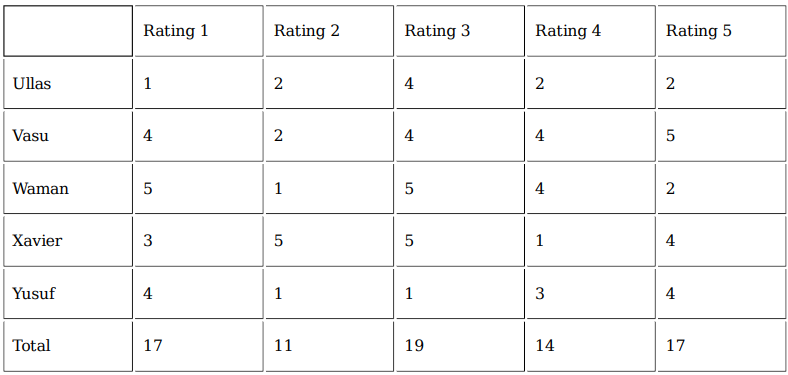
To how many workers did R2 give a rating of 4?
Video Explanation

Explanatory Answer
Step 1:
Mean rating of Ullas is 2.2. So his total rating = 2.2 × 5 = 11.
Since his median rating is 2.
So his middle most rating is 2.
Since his mode rating is 2. So his one more rating is 2.
Since his range of rating is 3. So his two ratings are 1 and 5 or 2 and 5 or 1 and 4.
Hence, only possible ratings of Ullas is (1, 2, 2, 2, 4).
Mean rating of Vasu is 3.8. So his total rating is 3.8 × 5 = 19. His median rating is 4. So his middle most rating is 4.
His mode rating is 4. So his one more rating is 4.
Since range of rating is 3. So only possible ratings of Vasu is (2, 4, 4, 4, 5).
Similarly, possible ratings of Waman, Xavier and Yusuf are (1, 2, 4, 5, 5), (1, 3, 4, 5, 5) and (1, 1, 3,
4, 4) respectively

What rating did R1 give to Xavier?
Video Explanation

Explanatory Answer
Step 1:
Mean rating of Ullas is 2.2. So his total rating = 2.2 × 5 = 11.
Since his median rating is 2.
So his middle most rating is 2.
Since his mode rating is 2. So his one more rating is 2.
Since his range of rating is 3. So his two ratings are 1 and 5 or 2 and 5 or 1 and 4.
Hence, only possible ratings of Ullas is (1, 2, 2, 2, 4).
Mean rating of Vasu is 3.8. So his total rating is 3.8 × 5 = 19. His median rating is 4. So his middle most rating is 4.
His mode rating is 4. So his one more rating is 4.
Since range of rating is 3. So only possible ratings of Vasu is (2, 4, 4, 4, 5).
Similarly, possible ratings of Waman, Xavier and Yusuf are (1, 2, 4, 5, 5), (1, 3, 4, 5, 5) and (1, 1, 3,
4, 4) respectively

What is the median of the ratings given by R3 to the five workers?
Video Explanation

Explanatory Answer
Step 1:
Mean rating of Ullas is 2.2. So his total rating = 2.2 × 5 = 11.
Since his median rating is 2.
So his middle most rating is 2.
Since his mode rating is 2. So his one more rating is 2.
Since his range of rating is 3. So his two ratings are 1 and 5 or 2 and 5 or 1 and 4.
Hence, only possible ratings of Ullas is (1, 2, 2, 2, 4).
Mean rating of Vasu is 3.8. So his total rating is 3.8 × 5 = 19. His median rating is 4. So his middle most rating is 4.
His mode rating is 4. So his one more rating is 4.
Since range of rating is 3. So only possible ratings of Vasu is (2, 4, 4, 4, 5).
Similarly, possible ratings of Waman, Xavier and Yusuf are (1, 2, 4, 5, 5), (1, 3, 4, 5, 5) and (1, 1, 3,
4, 4) respectively

Which among the following restaurants gave its median rating to exactly one of the workers?
Video Explanation

Explanatory Answer
Step 1:
Mean rating of Ullas is 2.2. So his total rating = 2.2 × 5 = 11.
Since his median rating is 2.
So his middle most rating is 2.
Since his mode rating is 2. So his one more rating is 2.
Since his range of rating is 3. So his two ratings are 1 and 5 or 2 and 5 or 1 and 4.
Hence, only possible ratings of Ullas is (1, 2, 2, 2, 4).
Mean rating of Vasu is 3.8. So his total rating is 3.8 × 5 = 19. His median rating is 4. So his middle most rating is 4.
His mode rating is 4. So his one more rating is 4.
Since range of rating is 3. So only possible ratings of Vasu is (2, 4, 4, 4, 5).
Similarly, possible ratings of Waman, Xavier and Yusuf are (1, 2, 4, 5, 5), (1, 3, 4, 5, 5) and (1, 1, 3,
4, 4) respectively

How many individual ratings cannot be determined from the above information?
Video Explanation

Explanatory Answer
Step 1:
Mean rating of Ullas is 2.2. So his total rating = 2.2 × 5 = 11.
Since his median rating is 2.
So his middle most rating is 2.
Since his mode rating is 2. So his one more rating is 2.
Since his range of rating is 3. So his two ratings are 1 and 5 or 2 and 5 or 1 and 4.
Hence, only possible ratings of Ullas is (1, 2, 2, 2, 4).
Mean rating of Vasu is 3.8. So his total rating is 3.8 × 5 = 19. His median rating is 4. So his middle most rating is 4.
His mode rating is 4. So his one more rating is 4.
Since range of rating is 3. So only possible ratings of Vasu is (2, 4, 4, 4, 5).
Similarly, possible ratings of Waman, Xavier and Yusuf are (1, 2, 4, 5, 5), (1, 3, 4, 5, 5) and (1, 1, 3,
4, 4) respectively

To how many workers did R2 give a rating of 4?
Video Explanation

Explanatory Answer
Step 1:
Mean rating of Ullas is 2.2. So his total rating = 2.2 × 5 = 11.
Since his median rating is 2.
So his middle most rating is 2.
Since his mode rating is 2. So his one more rating is 2.
Since his range of rating is 3. So his two ratings are 1 and 5 or 2 and 5 or 1 and 4.
Hence, only possible ratings of Ullas is (1, 2, 2, 2, 4).
Mean rating of Vasu is 3.8. So his total rating is 3.8 × 5 = 19. His median rating is 4. So his middle most rating is 4.
His mode rating is 4. So his one more rating is 4.
Since range of rating is 3. So only possible ratings of Vasu is (2, 4, 4, 4, 5).
Similarly, possible ratings of Waman, Xavier and Yusuf are (1, 2, 4, 5, 5), (1, 3, 4, 5, 5) and (1, 1, 3,
4, 4) respectively

What rating did R1 give to Xavier?
Video Explanation

Explanatory Answer
Step 1:
Mean rating of Ullas is 2.2. So his total rating = 2.2 × 5 = 11.
Since his median rating is 2.
So his middle most rating is 2.
Since his mode rating is 2. So his one more rating is 2.
Since his range of rating is 3. So his two ratings are 1 and 5 or 2 and 5 or 1 and 4.
Hence, only possible ratings of Ullas is (1, 2, 2, 2, 4).
Mean rating of Vasu is 3.8. So his total rating is 3.8 × 5 = 19. His median rating is 4. So his middle most rating is 4.
His mode rating is 4. So his one more rating is 4.
Since range of rating is 3. So only possible ratings of Vasu is (2, 4, 4, 4, 5).
Similarly, possible ratings of Waman, Xavier and Yusuf are (1, 2, 4, 5, 5), (1, 3, 4, 5, 5) and (1, 1, 3,
4, 4) respectively

What is the median of the ratings given by R3 to the five workers?
Video Explanation

Explanatory Answer
Step 1:
Mean rating of Ullas is 2.2. So his total rating = 2.2 × 5 = 11.
Since his median rating is 2.
So his middle most rating is 2.
Since his mode rating is 2. So his one more rating is 2.
Since his range of rating is 3. So his two ratings are 1 and 5 or 2 and 5 or 1 and 4.
Hence, only possible ratings of Ullas is (1, 2, 2, 2, 4).
Mean rating of Vasu is 3.8. So his total rating is 3.8 × 5 = 19. His median rating is 4. So his middle most rating is 4.
His mode rating is 4. So his one more rating is 4.
Since range of rating is 3. So only possible ratings of Vasu is (2, 4, 4, 4, 5).
Similarly, possible ratings of Waman, Xavier and Yusuf are (1, 2, 4, 5, 5), (1, 3, 4, 5, 5) and (1, 1, 3,
4, 4) respectively

Which among the following restaurants gave its median rating to exactly one of the workers?
Video Explanation

Explanatory Answer
Step 1:
Mean rating of Ullas is 2.2. So his total rating = 2.2 × 5 = 11.
Since his median rating is 2.
So his middle most rating is 2.
Since his mode rating is 2. So his one more rating is 2.
Since his range of rating is 3. So his two ratings are 1 and 5 or 2 and 5 or 1 and 4.
Hence, only possible ratings of Ullas is (1, 2, 2, 2, 4).
Mean rating of Vasu is 3.8. So his total rating is 3.8 × 5 = 19. His median rating is 4. So his middle most rating is 4.
His mode rating is 4. So his one more rating is 4.
Since range of rating is 3. So only possible ratings of Vasu is (2, 4, 4, 4, 5).
Similarly, possible ratings of Waman, Xavier and Yusuf are (1, 2, 4, 5, 5), (1, 3, 4, 5, 5) and (1, 1, 3,
4, 4) respectively

Faculty members in a management school can belong to one of four departments – Finance and Accounting (F&A), Marketing and Strategy (M&S), Operations and Quants (O&Q) and Behaviour and Human Resources (B&H). The numbers of faculty members in F&A, M&S, O&Q and B&H departments are 9, 7, 5 and 3 respectively.
Prof. Pakrasi, Prof. Qureshi, Prof. Ramaswamy and Prof. Samuel are four members of the school's faculty who were candidates for the post of the Dean of the school. Only one of the candidates was from O&Q.
Every faculty member, including the four candidates, voted for the post. In each department, all the faculty members who were not candidates voted for the same candidate. The rules for the election are listed below.
1. There cannot be more than two candidates from a single department.
2. A candidate cannot vote for himself/herself.
3. Faculty members cannot vote for a candidate from their own department.
After the election, it was observed that Prof. Pakrasi received 3 votes, Prof. Qureshi received 14 votes, Prof. Ramaswamy received 6 votes and Prof. Samuel received 1 vote. Prof. Pakrasi voted for Prof. Ramaswamy, Prof. Qureshi for Prof. Samuel, Prof. Ramaswamy for Prof. Qureshi and Prof. Samuel for Prof. Pakrasi.
Which two candidates can belong to the same department?
Video Explanation

Explanatory Answer
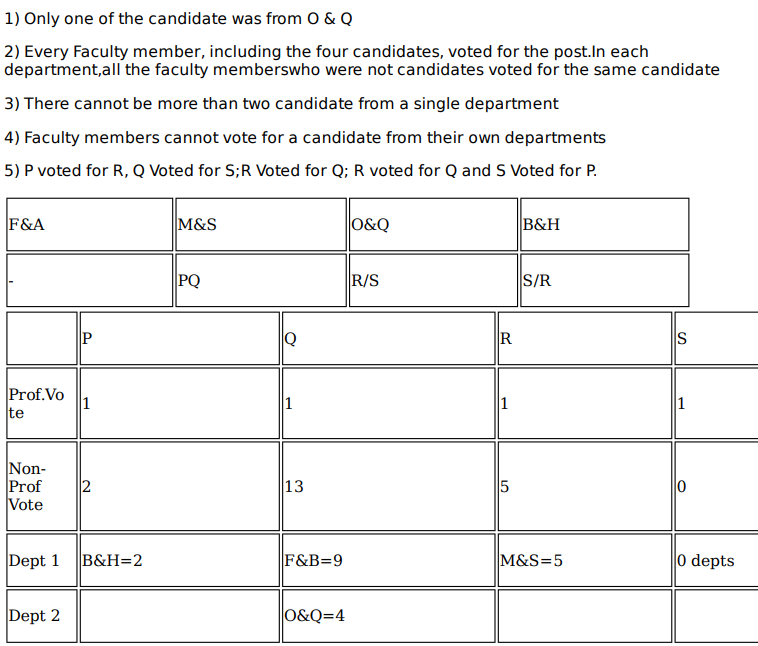
Which of the following can be the number of votes that Prof. Qureshi received from a single department?
Video Explanation

Explanatory Answer

If Prof. Samuel belongs to B&H, which of the following statements is/are true?
Statement A: Prof. Pakrasi belongs to M&S.
Statement B: Prof. Ramaswamy belongs to O&Q.
Video Explanation

Explanatory Answer

What best can be concluded about the candidate from O&Q?
Video Explanation

Explanatory Answer

Which of the following statements is/are true?
Statement A: Non-candidates from M&S voted for Prof. Qureshi.
Statement B: Non-candidates from F&A voted for Prof. Qureshi.
Video Explanation

Explanatory Answer

Which two candidates can belong to the same department?
Video Explanation

Explanatory Answer

Which of the following can be the number of votes that Prof. Qureshi received from a single department?
Video Explanation

Explanatory Answer

If Prof. Samuel belongs to B&H, which of the following statements is/are true?
Statement A: Prof. Pakrasi belongs to M&S.
Statement B: Prof. Ramaswamy belongs to O&Q.
Video Explanation

Explanatory Answer

What best can be concluded about the candidate from O&Q?
Video Explanation

Explanatory Answer

Which of the following statements is/are true?
Statement A: Non-candidates from M&S voted for Prof. Qureshi.
Statement B: Non-candidates from F&A voted for Prof. Qureshi.
Video Explanation

Explanatory Answer

A quadrilateral ABCD is inscribed in a circle such that AB : CD = 2 : 1 and BC : AD = 5 : 4. If AC and BD intersect at the point E, then AE : CE equals
Video Explanation

Explanatory Answer
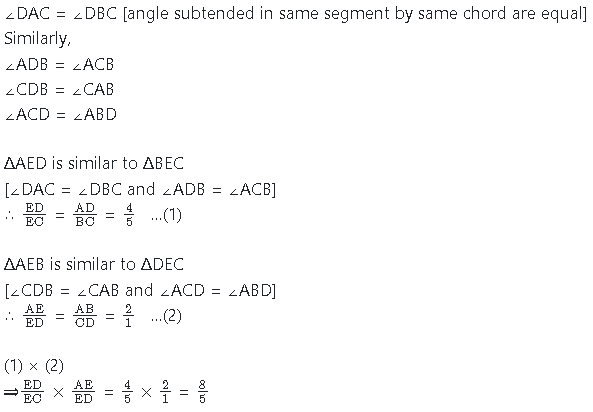
The amount of job that Amal, Sunil and Kamal can individually do in a day, are in harmonic progression. Kamal takes twice as much time as Amal to do the same amount of job. If Amal and Sunil work for 4 days and 9 days, respectively, Kamal needs to work for 16 days to finish the remaining job. Then the number of days Sunil will take to finish the job working alone, is
Video Explanation

Explanatory Answer
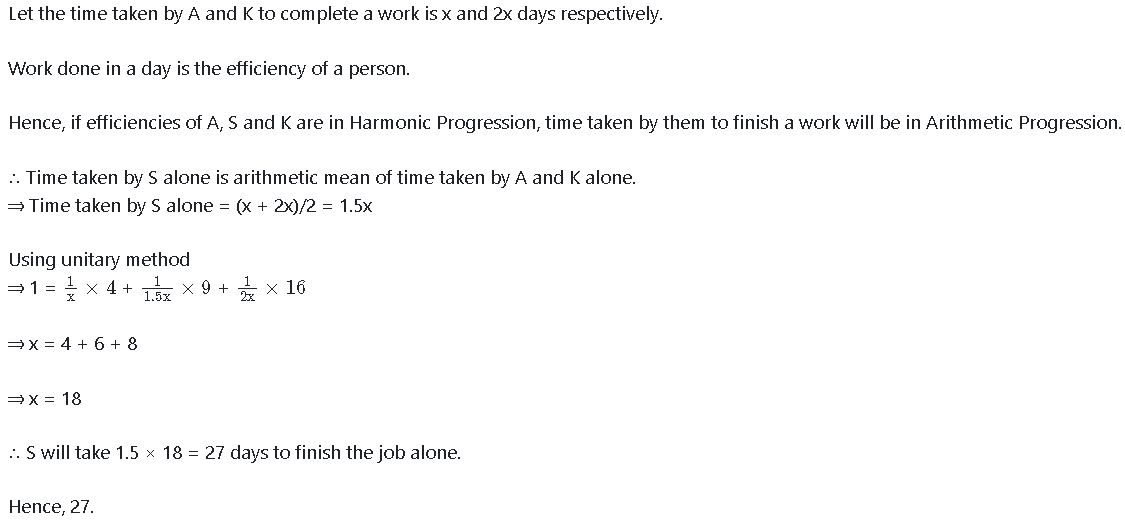
In an examination, the average marks of 4 girls and 6 boys is 24. Each of the girls has the same marks while each of the boys has the same marks. If the marks of any girl is at most double the marks of any boy, but not less than the marks of any boy, then the number of possible distinct integer values of the total marks of 2 girls and 6 boys is
Video Explanation

Explanatory Answer

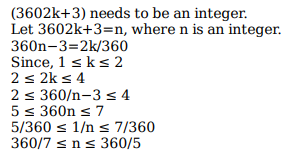
The salaries of three friends Sita, Gita and Mita are initially in the ratio 5 : 6 : 7, respectively. In the first year, they get salary hikes of 20%, 25% and 20%, respectively. In the second year, Sita and Mita get salary hikes of 40% and 25%, respectively, and the salary of Gita becomes equal to the mean salary of the three friends. The salary hike of Gita in the second year is
Video Explanation

Explanatory Answer
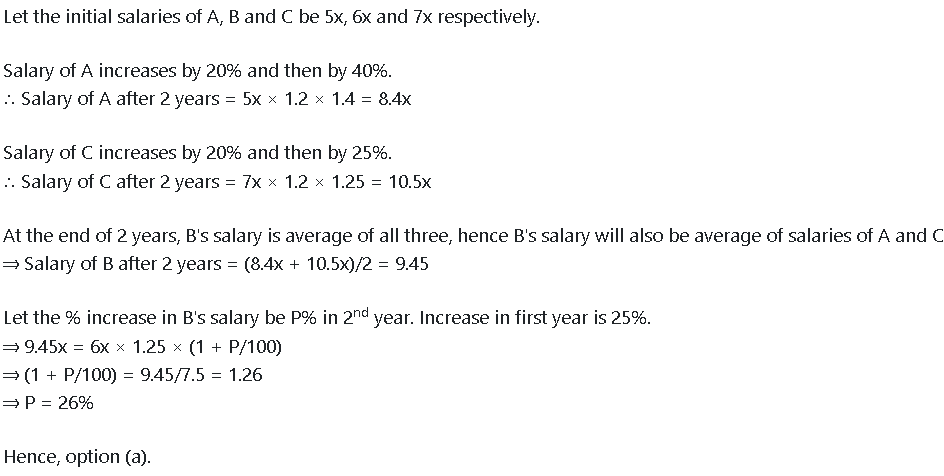
Let n be the least positive integer such that 168 is a factor of 1134n . If m is the least positive integer such that 1134n is a factor of 168m , then n+nm+m equals
Video Explanation

Explanatory Answer
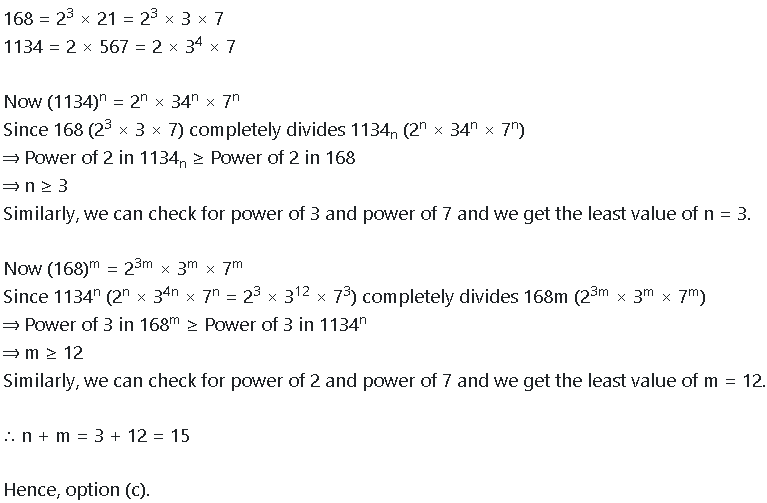
A lab experiment measures the number of organisms at 8 am every day. Starting with 2 organisms on the first day, the number of organisms on any day is equal to 3 more than twice the number on the previous day. If the number of organisms on the nth day exceeds one million, then the lowest possible value of n is
Video Explanation

Explanatory Answer

Arvind travels from town A to town B, and Surbhi from town B to town A, both starting at the same time along the same route. After meeting each other, Arvind takes 6 hours to reach town B while Surbhi takes 24 hours to reach town A. If Arvind travelled at a speed of 54 km/h, then the distance, in km, between town A and town B is
Video Explanation

Explanatory Answer

Anil invests Rs. 22000 for 6 years in a certain scheme with 4% interest per annum, compounded half-yearly. Sunil invests in the same scheme for 5 years, and then reinvests the entire amount received at the end of 5 years for one year at 10% simple interest. If the amounts received by both at the end of 6 years are same, then the initial investment made by Sunil, in rupees, is
Video Explanation

Explanatory Answer
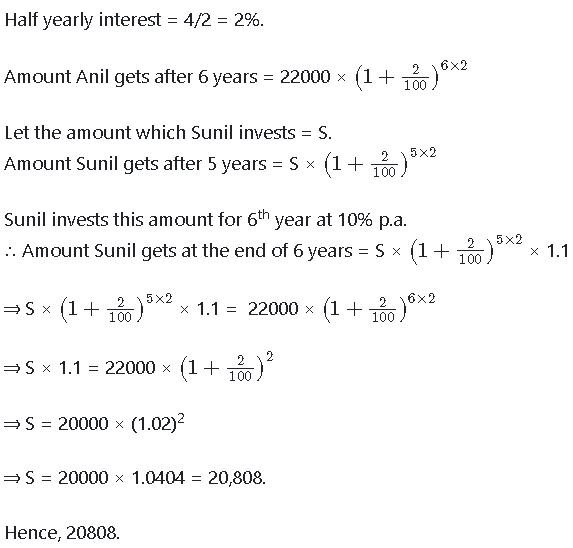
The minor angle between the hours hand and minutes hand of a clock was observed at 8:48 AM. The minimum duration, in minutes, after 8.48 am when this angle increases by 50% is
Video Explanation

Explanatory Answer
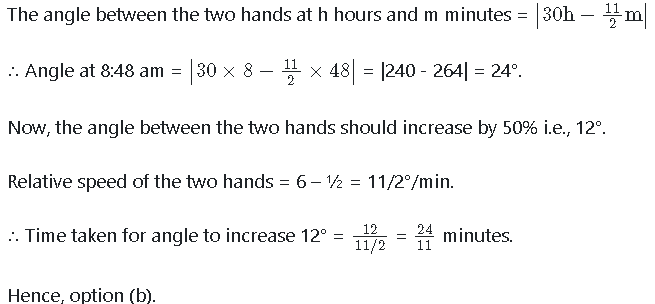
Gita sells two objects A and B at the same price such that she makes a profit of 20% on object A and a loss of 10% on object B. If she increases the selling price such that objects A and B are still sold at an equal price and a profit of 10% is made on object B, then the profit made on object A will be nearest to
Video Explanation

Explanatory Answer

Brishti went on an 8-hour trip in a car. Before the trip, the car had travelled a total of X km till then, where X is a whole number and is palindromic, i.e., X remains unchanged when its digits are reversed. At the end of the trip, the car had travelled a total of 26862 km till then, this number again being palindromic. If Brishti never drove at more than 110km/h , then the greatest possible average speed at which she drove during the trip, in km/h, was
Video Explanation

Explanatory Answer

A mixture P is formed by removing a certain amount of coffee from a coffee jar and replacing the same amount with cocoa powder. The same amount is again removed from mixture P and replaced with same amount of cocoa powder to form a new mixture Q. If the ratio of coffee and cocoa in the mixture Q is 16 : 9, then the ratio of cocoa in mixture P to that in mixture Q is
Video Explanation

Explanatory Answer
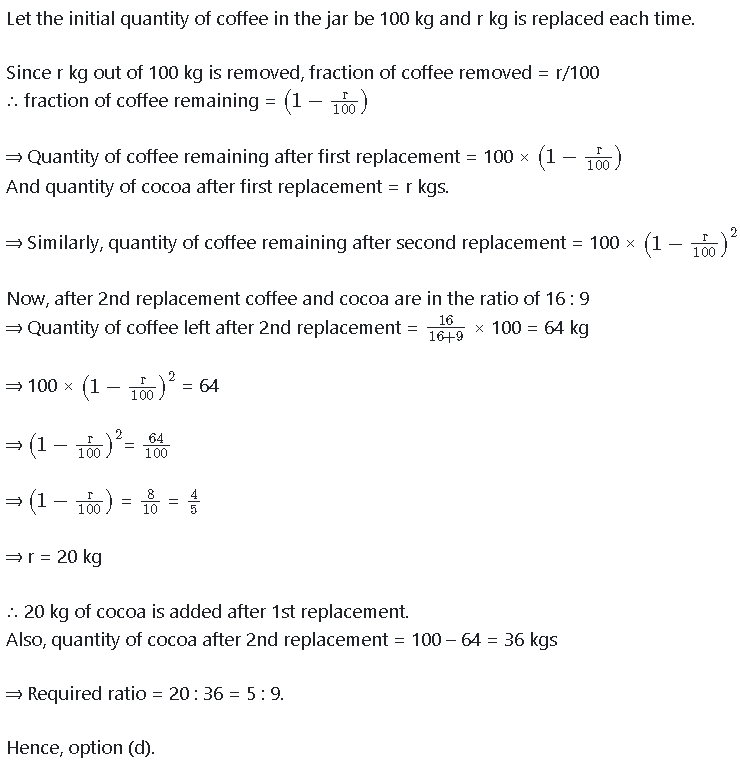
In a right-angled triangle ABC, the altitude AB is 5 cm, and the base BC is 12 cm. P and Q are two points on BC such that the areas of ΔABP, ΔABQ and ΔABC are in arithmetic progression. If the area of ΔABC is 1.5 times the area of ΔABP, the length of PQ, in cm, is
Video Explanation

Explanatory Answer
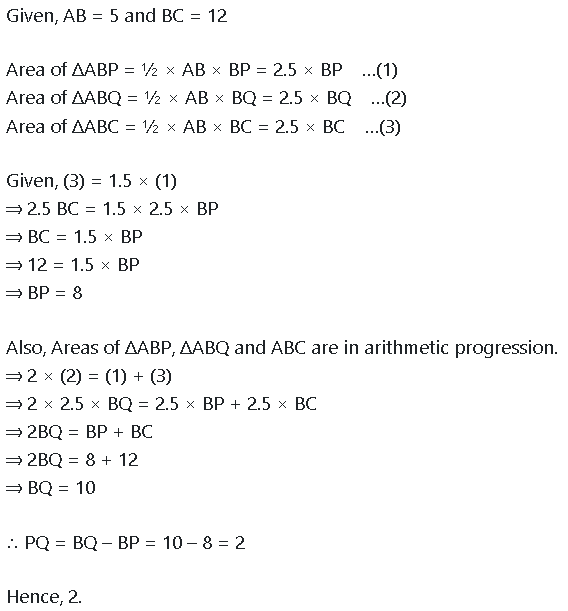
The number of all natural numbers up to 1000 with non-repeating digits is
Video Explanation

Explanatory Answer

The passage given below is followed by four alternate summaries. Choose the option that best captures the essence of the passage.
Foreign peacekeepers often exist in a bubble in the poor countries in which they are deployed; they live in posh compounds, drive fancy vehicles, and distance themselves from locals. This may be partially justified as they are outsiders, living in constant fear, performing a job that is emotionally draining. But they are often despised by the locals, and many would like them to leave. A better solution would be bottom-up peacebuilding, which would involve their spending more time working with communities, understanding their grievances and earning their trust, rather than only meeting government officials.
Video Explanation

Explanatory Answer
The paragraph given states that while foreign peacekeepers, due to some valid reasons, tend to live in a bubble in the poor countries where they are deployed, a bottom-up peacebuilding approach working in concert with the locals would be more effective. Option C summarises the paragraph well.
Option A does not touch upon the idea of bottom-up peace building. So, it is incorrect.
The paragraph does not say locals would be better at peacekeeping; B is incorrect.
The paragraph also does not say local anger against foreign peacekeepers makes them 'the target of local anger'. Option D is also incorrect.
The passage given below is followed by four alternate summaries. Choose the option that best captures the essence of the passage.
Developing countries are becoming hotbeds of business innovation in much the same way as Japan did from the 1950s onwards. They are reinventing systems of production and distribution, and experimenting with entirely new business models. Why are countries that were until recently associated with cheap hands now becoming leaders in innovation? Driven by a mixture of ambition and fear they are relentlessly climbing up the value chain. Emerging-market champions have not only proved highly competitive in their own backyards, they are also going global themselves
Video Explanation

Explanatory Answer
The main idea of the given paragraph is that driven by ambition and fear, developing countries are becoming leaders in innovation and are highly competitive both domestically and globally. Option C touches upon all key ideas of the paragraph.
Option A states that developing countries have invented new business models solely to remain competitive domestically. This is incorrect.
Option B is true but is not as comprehensive a summary as option C.
Option D states that production and distribution models are going through innovations 'worldwide'. The paragraph given only talks about developing countries innovating and transforming.
The passage given below is followed by four alternate summaries. Choose the option that best captures the essence of the passage.
McGurk and MacDonald (1976) reported a powerful multisensory illusion occurring with audio-visual speech. They recorded a voice articulating a consonant 'ba-ba-ba' and dubbed it with a face articulating another consonant 'ga-ga-ga'. Even though the acoustic speech signal was well recognized alone, it was heard as another consonant after dubbing with incongruent visual speech i.e., 'da-da-da'. The illusion, termed as the McGurk effect, has been replicated many times, and it has sparked an abundance of research. The reason for the great impact is that this is a striking demonstration of multisensory integration, where that auditory and visual information is merged into a unified, integrated percept.
Video Explanation

Explanatory Answer
The paragraph given explains the McGurk effect“ the merging of auditory and visual information into a unified integrated percept. Where there is a mismatch of audio and video signals, the message perceived is completely different from either of the signals. Option D summarises the paragraph well.
Option A is incorrect, as it says that the 'acoustic speech signal is confusing and integration of the two is imperfect'. The integration of the signals is not imperfect and both speech and audio signals are perceived differently in case of a mismatch.
Option B is incorrect too, as there is no 'winning' signal.
What option C states is true, but it does not summarise the main idea of the paragraph.
Which one of the following cannot be inferred from Alexandra Schnell's experiment?
Video Explanation

Explanatory Answer
The passage states that 'most of the animals' that can exercise self-control are social. Cuttlefish exhibit self-control and are not social. So, option A is not inferred from the experiment.
Options B, C and D are easily inferred from the information given in the passage.
The passage below is accompanied by a set of questions. Choose the best answer to each question.
Cuttlefish are full of personality, as behavioral ecologist Alexandra Schnell found out while researching the cephalopod's potential to display self-control. . . . "Self-control is thought to be the cornerstone of intelligence, as it is an important prerequisite for complex decision-making and planning for the future," says Schnell . . .
[Schnell's] study used a modified version of the "marshmallow test" . . . During the original marshmallow test, psychologist Walter Mischel presented children between age four and six with one marshmallow. He told them that if they waited 15 minutes and didn't eat it, he would give them a second marshmallow. A long-term follow-up study showed that the children who waited for the second marshmallow had more success later in life. . . . The cuttlefish version of the experiment looked a lot different. The researchers worked with six cuttlefish under nine months old and presented them with seafood instead of sweets. (Preliminary experiments showed that cuttlefishes' favorite food is live grass shrimp, while raw prawns are so-so and Asian shore crab is nearly unacceptable.) Since the researchers couldn't explain to the cuttlefish that they would need to wait for their shrimp, they trained them to recognize certain shapes that indicated when a food item would become available. The symbols were pasted on transparent drawers so that the cuttlefish could see the food that was stored inside. One drawer, labeled with a circle to mean "immediate," held raw king prawn. Another drawer, labeled with a triangle to mean "delayed," held live grass shrimp. During a control experiment, square labels meant "never."
"If their self-control is flexible and I hadn't just trained them to wait in any context, you would expect the cuttlefish to take the immediate reward [in the control], even if it's their second preference," says Schnell . . . and that's what they did. That showed the researchers that cuttlefish wouldn't reject the prawns if it was the only food available. In the experimental trials, the cuttlefish didn't jump on the prawns if the live grass shrimp were labeled with a triangle”many waited for the shrimp drawer to open up. Each time the cuttlefish showed it could wait, the researchers tacked another ten seconds on to the next round of waiting before releasing the shrimp. The longest that a cuttlefish waited was 130 seconds.
Schnell [says] that the cuttlefish usually sat at the bottom of the tank and looked at the two food items while they waited, but sometimes, they would turn away from the king prawn "as if to distract themselves from the temptation of the immediate reward." In past studies, humans, chimpanzees, parrots and dogs also tried to distract themselves while waiting for a reward.
Not every species can use self-control, but most of the animals that can share another trait in common: long, social lives. Cuttlefish, on the other hand, are solitary creatures that don't form relationships even with mates or young. . . . "We don't know if living in a social group is important for complex cognition unless we also show those abilities are lacking in less social species," says . . . comparative psychologist Jennifer Vonk.
All of the following constitute a point of difference between the "original" and "modified" versions of the marshmallow test EXCEPT that:
Video Explanation

Explanatory Answer
The passage does not state that the modified version of the marshmallow test aimed to correlate self-control with survival advantages.
The differences mentioned in options B, C and D are discussed in the passage. While in the original test, children had to wait for 15 minutes to get the second marshmallow, the longest a cuttlefish waited was 130 seconds. Options C and D are clearly true.
Which one of the following, if true, would best complement the passage's findings?
Video Explanation

Explanatory Answer
The key finding of the experiment is that cuttlefish exhibit self-control. According to the passage, species that exhibit self-control are usually social. Cuttlefish are not. But if it were true that cuttlefish exhibit sociability, you could conclude that like most other social creatures, cuttlefish, too, exhibit self-control. So if option B were true, the findings of the passage would be in line with what is generally observed. So, that way, it would complement the findings.
All other options don't relate positively with the passage's findings. The passage states cuttlefish waited up to 130 sec for the shrimp to be released, so option 1 doesn't add to the findings in any way. If the cuttlefish cannot recognise shapes, then the basic premise of the experiment“ that they see the shape pasted on the drawer and decide whether to wait“ is negated. If cuttlefish are equally fond of shrimp and prawn, there is no reason for them to wait. So, all other options are ruled out.
In which one of the following scenarios would the cuttlefish's behaviour demonstrate self-control?
Video Explanation

Explanatory Answer
In the experiment, cuttlefish were trained to recognise circle to mean 'immediate', triangle to mean 'delayed' and square to mean 'never'. The passage also states that cuttlefishes' favorite food is live grass shrimp, while raw prawns are so-so and Asian shore crab is nearly unacceptable. So, the cuttlefish would demonstrate self -control if they waited for live grass shrimp labelled with a triangle to be opened while other food was readily available.
Which one of the following cannot be inferred from Alexandra Schnell's experiment?
Video Explanation

Explanatory Answer
The passage states that 'most of the animals' that can exercise self-control are social. Cuttlefish exhibit self-control and are not social. So, option A is not inferred from the experiment.
Options B, C and D are easily inferred from the information given in the passage.
All of the following constitute a point of difference between the "original" and "modified" versions of the marshmallow test EXCEPT that:
Video Explanation

Explanatory Answer
The passage does not state that the modified version of the marshmallow test aimed to correlate self-control with survival advantages.
The differences mentioned in options B, C and D are discussed in the passage. While in the original test, children had to wait for 15 minutes to get the second marshmallow, the longest a cuttlefish waited was 130 seconds. Options C and D are clearly true.
Which one of the following, if true, would best complement the passage's findings?
Video Explanation

Explanatory Answer
The key finding of the experiment is that cuttlefish exhibit self-control. According to the passage, species that exhibit self-control are usually social. Cuttlefish are not. But if it were true that cuttlefish exhibit sociability, you could conclude that like most other social creatures, cuttlefish, too, exhibit self-control. So if option B were true, the findings of the passage would be in line with what is generally observed. So, that way, it would complement the findings.
All other options don't relate positively with the passage's findings. The passage states cuttlefish waited up to 130 sec for the shrimp to be released, so option 1 doesn't add to the findings in any way. If the cuttlefish cannot recognise shapes, then the basic premise of the experiment“ that they see the shape pasted on the drawer and decide whether to wait“ is negated. If cuttlefish are equally fond of shrimp and prawn, there is no reason for them to wait. So, all other options are ruled out.
In which one of the following scenarios would the cuttlefish's behaviour demonstrate self-control?
Video Explanation

Explanatory Answer
In the experiment, cuttlefish were trained to recognise circle to mean 'immediate', triangle to mean 'delayed' and square to mean 'never'. The passage also states that cuttlefishes' favorite food is live grass shrimp, while raw prawns are so-so and Asian shore crab is nearly unacceptable. So, the cuttlefish would demonstrate self -control if they waited for live grass shrimp labelled with a triangle to be opened while other food was readily available.
All of the following arguments are made in the passage EXCEPT that:
Video Explanation

Explanatory Answer
Another tricky question. The passage states that 'in More's time, for much of the population, given the plenty and security on offer, such restraints would not have seemed overly unreasonable'. Option A alters a few words and changes the meaning of what is stated in the passage. The passage does not say people 'need' restraints.
Option B is true, based on the second paragraph which states that the tradition which follows More 'often portrays societies where . . . 'it would be almost impossible for man to be depraved, or wicked'.
Option C is true based on the last few lines of the passage: 'For we have only to acknowledge the existence of thousands of successful intentional communities in which a cooperative ethos predominates and where harmony without coercion is the rule to set aside such an assertion'.
From the last few lines of the second paragraph, we know option D is true : 'Unity, order, and homogeneity thus prevail at the cost of individuality and diversity. This model, as J. C. Davis demonstrates, dominated early modern utopianism'.
The passage below is accompanied by a set of questions. Choose the best answer to each question.
We cannot travel outside our neighbourhood without passports. We must wear the same plain clothes. We must exchange our houses every ten years. We cannot avoid labour. We all go to bed at the same time . . . We have religious freedom, but we cannot deny that the soul dies with the body, since 'but for the fear of punishment, they would have nothing but contempt for the laws and customs of society'. . . . In More's time, for much of the population, given the plenty and security on offer, such restraints would not have seemed overly unreasonable. For modern readers, however, Utopia appears to rely upon relentless transparency, the repression of variety, and the curtailment of privacy. Utopia provides security: but at what price? In both its external and internal relations, indeed, it seems perilously dystopian.
Such a conclusion might be fortified by examining selectively the tradition which follows More on these points. This often portrays societies where . . . 'it would be almost impossible for man to be depraved, or wicked'. . . . This is achieved both through institutions and mores, which underpin the common life. . . . The passions are regulated and inequalities of wealth and distinction are minimized. Needs, vanity, and emulation are restrained, often by prizing equality and holding riches in contempt. The desire for public power is curbed. Marriage and sexual intercourse are often controlled: in Tommaso Campanella's The City of the Sun (1623), the first great literary utopia after More's, relations are forbidden to men before the age of twenty-one and women before nineteen. Communal child-rearing is normal; for Campanella this commences at age two. Greater simplicity of life, 'living according to nature', is often a result: the desire for simplicity and purity are closely related. People become more alike in appearance, opinion, and outlook than they often have been. Unity, order, and homogeneity thus prevail at the cost of individuality and diversity. This model, as J. C. Davis demonstrates, dominated early modern utopianism. . . . And utopian homogeneity remains a familiar theme well into the twentieth century.
Given these considerations, it is not unreasonable to take as our starting point here the hypothesis that utopia and dystopia evidently share more in common than is often supposed. Indeed, they might be twins, the progeny of the same parents. Insofar as this proves to be the case, my linkage of both here will be uncomfortably close for some readers. Yet we should not mistake this argument for the assertion that all utopias are, or tend to produce, dystopias. Those who defend this proposition will find that their association here is not nearly close enough. For we have only to acknowledge the existence of thousands of successful intentional communities in which a cooperative ethos predominates and where harmony without coercion is the rule to set aside such an assertion. Here the individual's submersion in the group is consensual (though this concept is not unproblematic). It results not in enslavement but voluntary submission to group norms. Harmony is achieved without . . . harming others.
Following from the passage, which one of the following may be seen as a characteristic of a utopian society?
Video Explanation

Explanatory Answer
Note these lines that describe Utopia in the first paragraph: 'Utopia appears to rely upon relentless transparency, the repression of variety, and the curtailment of privacy. Utopia provides security: but at what price?' So, institutional surveillance in the name of security can be seen as a characteristic of a Utopian society. Options A and D are also ruled out from these lines. In the second paragraph, the passage mentions that Utopia curbs the desire for public power and promotes equality. So, option C is also incorrect.
Which sequence of words below best captures the narrative of the passage?
Video Explanation

Explanatory Answer
A tricky question. All options contain words that are key ideas in the passage. So, to choose the correct option, we need to look at an important idea that is missed in some options. Options B and C can be ruled out this way, as they do not mention 'intentional communities' which is a key idea in the last paragraph. Between options A and B, option A does not mention the idea of 'homogeneity', which the passage talks about in detail in the second paragraph. Option D includes both these ideas and hence it best captures the narrative of the passage.
All of the following statements can be inferred from the passage EXCEPT that:
Video Explanation

Explanatory Answer
A tricky question. The author starts the last paragraph saying that as utopia and dystopia share a lot in common, it may not be unreasonable to start with the hypothesis that they are 'twins'. But the author goes on to say that while the two are 'uncomfortably close', 'we should not mistake this argument for the assertion that all utopias are, or tend to produce, dystopias. Those who defend this proposition will find that their association here is not nearly close enough'. In other words, utopias are not dystopias and the two cannot be regarded as exactly alike, or twins. Option B cannot be inferred from the passage.
Option A can be inferred, from the lines 'Utopia provides security: but at what price? In both its external and internal relations, indeed, it seems perilously dystopian'.
In the second paragraph, the passage talks about the literary utopia of More and Campanella with imaginary customs and rules being practised in these imaginary societies. So, option C can be inferred.
Again, from the last lines of the second paragraph 'utopian homogeneity remains a familiar theme well into the twentieth century', option D can also be inferred.
All of the following arguments are made in the passage EXCEPT that:
Video Explanation

Explanatory Answer
Another tricky question. The passage states that 'in More's time, for much of the population, given the plenty and security on offer, such restraints would not have seemed overly unreasonable'. Option A alters a few words and changes the meaning of what is stated in the passage. The passage does not say people 'need' restraints.
Option B is true, based on the second paragraph which states that the tradition which follows More 'often portrays societies where . . . 'it would be almost impossible for man to be depraved, or wicked'.
Option C is true based on the last few lines of the passage: 'For we have only to acknowledge the existence of thousands of successful intentional communities in which a cooperative ethos predominates and where harmony without coercion is the rule to set aside such an assertion'.
From the last few lines of the second paragraph, we know option D is true : 'Unity, order, and homogeneity thus prevail at the cost of individuality and diversity. This model, as J. C. Davis demonstrates, dominated early modern utopianism'.
Following from the passage, which one of the following may be seen as a characteristic of a utopian society?
Video Explanation

Explanatory Answer
Note these lines that describe Utopia in the first paragraph: 'Utopia appears to rely upon relentless transparency, the repression of variety, and the curtailment of privacy. Utopia provides security: but at what price?' So, institutional surveillance in the name of security can be seen as a characteristic of a Utopian society. Options A and D are also ruled out from these lines. In the second paragraph, the passage mentions that Utopia curbs the desire for public power and promotes equality. So, option C is also incorrect.
Which sequence of words below best captures the narrative of the passage?
Video Explanation

Explanatory Answer
A tricky question. All options contain words that are key ideas in the passage. So, to choose the correct option, we need to look at an important idea that is missed in some options. Options B and C can be ruled out this way, as they do not mention 'intentional communities' which is a key idea in the last paragraph. Between options A and B, option A does not mention the idea of 'homogeneity', which the passage talks about in detail in the second paragraph. Option D includes both these ideas and hence it best captures the narrative of the passage.









